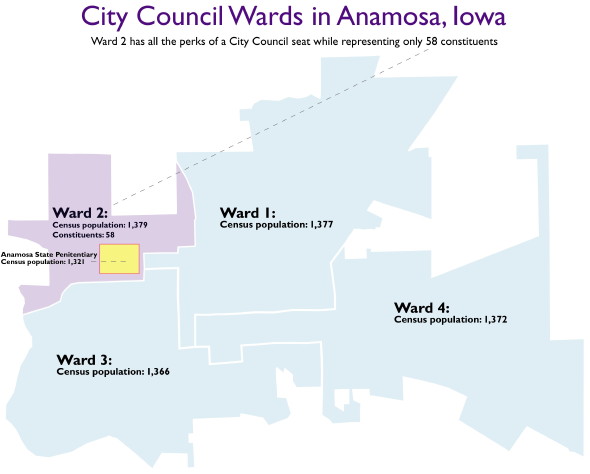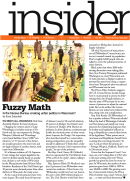by Peter Wagner,
October 24, 2008
Sam Roberts of the New York Times has written an excellent article about Anamosa Iowa where a prison amounts to 96% of a city council ward:
Danny R. Young, a 53-year-old backhoe operator for Jones County in eastern Iowa, was elected to the Anamosa City Council with a total of two votes — both write-ins, from his wife and a neighbor.
While the Census Bureau says Mr. Young’s ward has roughly the same population as the city’s three others, or about 1,400 people, his constituents wield about 25 times more political clout.
That is because his ward includes 1,300 inmates housed in Iowa’s largest penitentiary — none of whom can vote. Only 58 of the people who live in Ward 2 are nonprisoners. That discrepancy has made Anamosa a symbol for a national campaign to change the way the Census Bureau counts prison inmates.
The article highlights the efforts of Bertha Finn, who organized a referendum last year which abolished the prison district by switching the small city to an at-large system of government. I’m quoted in the article cheering the people of Anamosa on:
“The people of Anamosa have the right idea,” Mr. Wagner said. “A small group of people should not be allowed to dominate government just because the Census Bureau counted a large prison there.”
Read the full article, Census Bureau’s Counting of Prisoners Benefits Some Rural Voting Districts on the New York Times site.
You can also read previous blog posts and reports about some of the other places discussed in the Times:
If you live in a small community with a large prison, be sure to check out our Democracy Toolkit to determine if — and to what degree — prison populations are distorting your access to local government.
And finally, this map was made by our friend Adell Donaghue to illustrate the current — and soon to be abolished — unequal districts in Anamosa, Iowa:

by Peter Wagner,
October 20, 2008
According to the Chippewa Herald, the construction of new state prisons in Chippewa County, Wisconsin has inflated county population estimates, making the county appear to be the 4th fastest growing county in the state. The population estimates were prepared by the state, but are based on U.S. Census methodology that counts people in prison as residents of the prison location. Depending on how the data is used, crediting thousands of prisoners to the wrong spot can create a mildly annoying — or amusing — distortion in a county’s statistical image.
But Chippewa County is about to experience a far more serious impact from the prison miscount that could radically dilute the political power of almost every county resident over their own government.
Continue reading →
by Evan Solochek,
September 17, 2008
This article originally appeared in the print edition of Milwaukee Magazine.
 You might call Wisconsin’s 53rd State Assembly District the land of prisons. Hugging the western shore of Lake Winnebago, it includes sections of Oshkosh and also encompasses the Dodge, Waupun, Oshkosh and Winnebago correctional facilities. Some 5,000 “constituents,” or 9.5 percent of the district, are actually prisoners who don’t vote and are legal residents of another district, with many from Milwaukee.
You might call Wisconsin’s 53rd State Assembly District the land of prisons. Hugging the western shore of Lake Winnebago, it includes sections of Oshkosh and also encompasses the Dodge, Waupun, Oshkosh and Winnebago correctional facilities. Some 5,000 “constituents,” or 9.5 percent of the district, are actually prisoners who don’t vote and are legal residents of another district, with many from Milwaukee.
It’s a blatant violation of US. Supreme Court rulings that require legislative districts be divided equally based on population, declares a new study of Wisconsin by the Massachusetts-based Prison Policy Initiative. Residents of the 53rd District get 10 percent more electoral power than other districts in Wisconsin, the study notes.
Continue reading →
by Eric Schneiderman and Tedra Cobb,
May 28, 2008
May 27, 2008
Diana Hynek
Departmental Paperwork Clearance Officer
Department of Commerce, Room 6625
14th and Constitution Avenue, NW
Washington, DC 20230
VIA ELECTRONIC MAIL: dHynek@doc.gov
Re: Collecting the addresses of incarcerated people in the 2010 Census
Dear Ms. Hynek,
We are writing to urge the United States Census Bureau to collect the home addresses of all incarcerated persons in the 2010 Census. In October 2007, we sent then director Kincannon a letter co-signed by 30 federal, state and local legislators requesting that the Bureau change how it counts the prison population. Counting people in prison at their pre-incarceration address is essential for compliance with the “One Person, One Vote” rulings of the Supreme Court, which require that legislative districts at every level of government contain equal numbers of residents in order to ensure fair and equal representation for all. The Census is uniquely suited to perform this function, which will help us better serve our constituents, our states, and our country.
Currently, the Census Bureau includes everyone housed in federal, state, and local prisons in its count of the general population of the Census block that contains the prison. State laws, however, often define residence as the place where one voluntarily lives. Many states also have constitutional clauses or election law statutes that explicitly declare that incarceration does not change a residence. Prisoners therefore remain legal residents of their pre-incarceration addresses, and in situations where they retain voting rights, they send absentee ballots to their home districts. Unfortunately, the current census methodology opts to disregard this, instead counting a significant proportion of our national population in the wrong place. Crediting the population of prisoners to the Census block where they are temporarily and involuntarily held creates electoral inequities at all levels of government.
In our letter, we asked the Census Bureau to permanently eliminate this problem by counting people in prison as residents of their home addresses. Recognizing that time was short, we asked the Bureau to implement, as an interim solution, the recommendation of the National Research Council, and publish a special version of the PL94-171 redistricting data file for the prison population. Publishing detailed block-level counts of prison populations would empower legislators to remove those populations prior to redistricting. New York has relatively good record keeping procedures tracking the home addresses of inmates, but it is ultimately the duty of the U.S. Census Bureau to provide this information in a usable format for State and County Legislators. Furthermore, not all states find themselves with the same level of resources to locally correct this failing on the part of the Federal Census Bureau.
Unfortunately, we did not receive a positive response from then-Director Kincannon. On November 20, 2007 Director Kincannon wrote that the Bureau was not intending to change its method of counting the prison population. His arguments were based on the Census Bureau’s 2006 report, “Tabulating Prisoners at Their Permanent Home of Record Address,” the findings of which were rejected by the Census Bureau’s own commissioned experts at the National Research Council later that year. The Director’s response also failed to address our request for a special version of PL94-171 to facilitate data correction.
While it is true that improving the accuracy, fairness and utility of the census by changing how incarcerated people are counted would create an additional burden on the Bureau, we feel that the Bureau is making the burdens seem more significant than they really are.
For example, the Census Bureau argued that:
If a valid residential address (i.e., a complete address that can be verified to exist) were provided, the Census Bureau would have to verify the validity of tabulating the prisoner at that address which would require a new census operation to interview the current residents of the address.
The solution need not be so difficult. The Bureau could simply count prisoners the same way that people in non-institutional group quarters like migrant farmworkers, people in hostels, and members of religious orders: Count prisoners at the facility only if they do not report a usual and valid address elsewhere.
Likewise, the Census Bureau has argued that collecting home residence information would be difficult because it does not exist in a complete and usable form in administrative records. While the Census Bureau should certainly respond to the National Research Council’s repeated criticism of the Bureau’s over-reliance on administrative records to enumerate group quarters populations, the Census Bureau’s response runs to an opposite extreme. Interviewing an estimated 2.6 million incarcerated people in a private and confidential room would indeed be an expensive, time consuming and difficult operation. To date the Bureau has been reluctant to consider solutions based on its successful practice in other parts of the Census: use individual forms in most cases, and conduct in person interviews or indirect means of collecting the data only where necessary.
Given the Bureau’s failure to take concrete steps to change how incarcerated people are counted in the 2010 Census, we concede that the full reform we seek is difficult to realize in the 2010 Census. But time still exists for two very important steps.
First, the Census Bureau should adopt the recommendations of the National Research Council and conduct experiments during the 2010 census as part of a major research and testing program to evaluate assigning incarcerated people to other addresses outside the facility. The 2010 enumeration is an opportunity that should not be missed to test improvements.
Second, we again repeat our request that the Bureau implement as an interim solution, the recommendation of the National Research Council, and publish a special version of the PL94-171 redistricting data file for the prison population. Publishing detailed block-level counts of prison populations would empower legislators to remove those populations prior to redistricting. Again, Director Kincannon did not address this portion of our proposal in his November 2007 letter.
This special dataset would greatly assist counties and states with large prisons to drawing fair districts. The interest in an alternative tabulation is clear. Thirteen counties in New York already manually remove the prison population prior to redistricting, as do counties in Alabama, California, Colorado, Georgia, Illinois, Florida, Michigan, Mississippi, Oklahoma, South Carolina, and Virginia. Many of the counties that retain the prison populations do so only because they are unaware that prisoners are included in the Census, because they feel obligated to use the Census, or because they do not know how to adjust the data.
To manually adjust the Census, counties must rely on incompatible Department of Corrections data or on Summary File 1 data which is published several months after PL94-171. Jurisdictions covered by Section 5 of the Voting Rights Act have particular difficulties because they must often start — if not also complete — redistricting prior to the publication of Summary File 1. Further, these jurisdictions find it difficult to reconcile the partially incompatible racial and ethnic classifications in PL94-171 with the data published for correctional populations in Summary File 1. The Census Bureau is uniquely suited to eliminate these problems.
Publishing an alternative version of PL94-171 dataset that contained just the prison population at their prison addresses is well within the Bureau’s capabilities. There is no impact on data collection procedures and it requires only the publication of a small amount of data in a different format several months earlier than the Bureau would have done otherwise. Of the 8 million Census blocks in Census 2000, less than 6,000 contained a correctional facility. We are asking that the four tables in the PL94-171 redistricting data set be recalculated and published separately to show only the correctional populations in those 6,000 blocks. With this special tabulation, data users would be empowered to decide whether they want to draw districts based on the prison populations without wrestling with the technical questions. By subtracting one data set from another, data users can have a complete and accurate count of their population without the prisoners skewing the data.
This is not an ideal solution, but it is one that is well within the means of the Census Bureau to implement at this late date. We respectfully urge the Census Bureau to take all steps possible to help reduce and eventually eliminate the political inequities and unnecessary data complications that result from the flawed practice of counting people in prison as residents of the census block that contains the prison.
Sincerely,
Eric Schneiderman
New York State Senator, 31st District
Ranking Minority Member,
Senate Codes Committee
80 Bennett Avenue, LA
New York, NY 10033
Phone: 212-928-5578
Fax: 212-928-0396
Tedra L. Cobb
Vice-Chair
St. Lawrence County Legislature
District 8
365 Townline Road
Hermon, NY 13652
(315)386-4928 Phone and Fax
cc:
Steve H. Murdock, Director, U.S. Census Bureau
Frank Vitrano, U.S. Census Bureau
Catherine M. McCully, U.S. Census Bureau
Footnotes
by Brett Blank,
January 8, 2008
Cross-posted from TomPaine.com.
There once was a time when in the state of New Hampshire, wealth bought votes. It wasn’t illicit or even unusual. In fact it was the law of the state. The amount of power each Senate district had was directly proportional to its taxes paid. This method of redistricting was struck down in Reynolds v. Sims less than 45 years ago.
New Hampshire was not alone. Other states had fundamentally unfair apportionment schemes. For example, Alabama gave every county the same number of state senators. As a result, sparsely populated Lowndes County had the same number of state senators as densely populated Jefferson County. This too was struck down by Reynolds v. Sims.
Continue reading →

 You might call Wisconsin’s 53rd State Assembly District the land of prisons. Hugging the western shore of Lake Winnebago, it includes sections of Oshkosh and also encompasses the Dodge, Waupun, Oshkosh and Winnebago correctional facilities. Some 5,000 “constituents,” or 9.5 percent of the district, are actually prisoners who don’t vote and are legal residents of another district, with many from Milwaukee.
You might call Wisconsin’s 53rd State Assembly District the land of prisons. Hugging the western shore of Lake Winnebago, it includes sections of Oshkosh and also encompasses the Dodge, Waupun, Oshkosh and Winnebago correctional facilities. Some 5,000 “constituents,” or 9.5 percent of the district, are actually prisoners who don’t vote and are legal residents of another district, with many from Milwaukee. 




